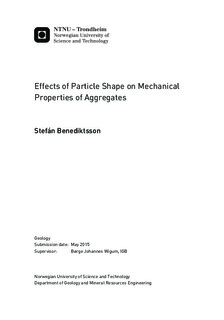Effects of Particle Shape on Mechanical Properties of Aggregates
Master thesis
Permanent lenke
http://hdl.handle.net/11250/2350432Utgivelsesdato
2015Metadata
Vis full innførselSamlinger
Sammendrag
Aggregates are one of the primary building material used in the world. The durability of construction aggregates will therefore depend upon the quality of aggregate mechanical properties. It is therefore important to understand how particle shape will effect mechanical properties of aggregates, measured by the Los Angeles and micro-Deval values. In order to assess the influence of particle shape on aggregate mechanical properties, the proportion of flaky and cubic particles, measured by the flakiness index (FI), was artificially varied in a series of tests for six different rock types. All in all 69 Los Angeles and 69 micro-Deval tests were performed according to European standards.
The main findings are that the standard Los Angeles (LA) and micro-Deval (MD) test methods which measure the amounts of fines (<1.6 mm) produced by impact and/or wear are generally not sensitive to variations in the flakiness index (FI). The LAx and MDx values, which are measured by the amounts of material passing the lower fraction of the size range, are more sensitive to variations in the flakiness index (FI). Sieve analysis also shows that the standard LA and MD method of measuring production of fines is not always a good indicator of aggregate breakdown and may in some cases ignore increased breakdown of the aggregate coarser than 1.6 mm. The LAx and MDx values better demonstrate the behavior of the aggregate coarser than 1.6 mm and give better information about the extent of aggregate breakdown.
